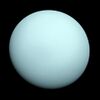Astronomy:New Horizons 2
New Horizons 2 (also New Horizons II, NHII, or NH2) was a proposed mission to the trans-Neptunian objects by NASA. It was conceived as a planetary flyby mission in 2002, based on the New Horizons spacecraft, which was in development at the time.[1][2] In March 2005, the proposal was not selected for further development because of a shortage of plutonium-238 needed for the radioisotope thermoelectric generator (RTG).[3] The New Horizons 2 study was funded out of the New Frontiers program, and was delivered to the U.S. Congress in June 2005.[4]
Description
New Horizons 2 was included in the tentative budget for the New Frontiers program missions.[5] In 2004 the United States Senate Appropriations Committee provided additional funding for New Horizons 2, a new Kuiper belt mission.[6] As early as 2004 there was a conference on how to make the most use of New Horizons 2's Uranus flyby.[7]
Candidate targets included 47171 Lempo, a system that, like Pluto–Charon, contains multiple bodies.[5] The mission plan for Lempo also included flybys of Jupiter and Uranus,[5] and perhaps four Kuiper belt objects (KBO).[8] There was a lot of flexibility: even without a gravity assist any KBO within 50 AU and a 20-year flight time was possible.[9] A flyby of Neptune's Triton was also considered, with 66652 Borasisi as a potential follow on.[9] 2002 UX25 was also considered to be visited, having a similar orbit as Lempo.[10]
See also
- Innovative Interstellar Explorer (2003 concept study for RTG powered ion-engined probe to 200 AU by 2030)
- List of New Horizons topics
References
- ↑ "New Horizons II (2004-2005) | Wired Science | Wired.com". 2012-05-26. https://www.wired.com/wiredscience/2012/05/new-horizons-ii-2004-2005/.
- ↑ Stern, Alan; Binzel, Rick. "New Horizons 2". Lunar and Planetary Institute. http://www.lpi.usra.edu/opag/new_horizons2.pdf.
- ↑ "New Horizons II Final Report - March 2005". http://www.lpi.usra.edu/opag/nh2_final_report.pdf.
- ↑ "Presentation: SSE Decadal Survey and New Horizons: A Rough Start". June 2005. http://www.lpi.usra.edu/opag/meetings/jun2005/presentations/NH2_Decadal_API.pdf.
- ↑ 5.0 5.1 5.2 Czysz, Paul A.; Bruno, Claudio (2009-03-20). Future Spacecraft Propulsion Systems: Enabling Technologies for Space Exploration. Springer. p. 378. ISBN 9783540888147. https://books.google.com/books?id=aI9QhDA4AVwC&pg=PA378.
- ↑ Stern, Alan (October 5, 2004). "New Horizons For Planetary Exploration". http://www.spacedaily.com/news/outerplanets-04h.html.
- ↑ "Revolution Afoot-- Cheaper, More Frequent Outer Planets Missions - New Horizons II Workshop". June 5, 2004. https://spaceref.com/press-release/revolution-afoot-cheaper-more-frequent-outer-planets-missions-new-horizons-ii-workshop/.
- ↑ Stern, Alan. "New Horizons 2". NASA (Outer Planets Assessment Group). http://www.lpi.usra.edu/opag/new_horizons2.pdf. parent
- ↑ 9.0 9.1 "Final Report of the New Horizons II Review Panel". http://www.lpi.usra.edu/opag/nh2_final_report.pdf.
- ↑ Portree, David S. F.. "No Shortage of Dreams: New Horizons II (2004-2005)". http://spaceflighthistory.blogspot.com/2015/07/new-horizons-ii-2004-2005.html.
External links
 |










